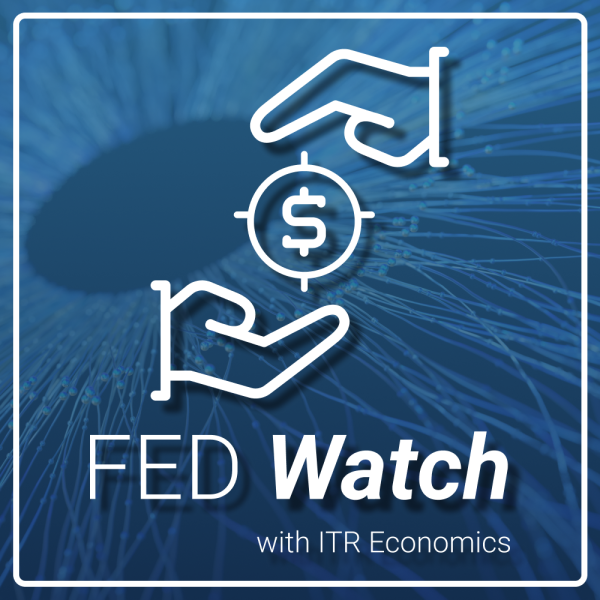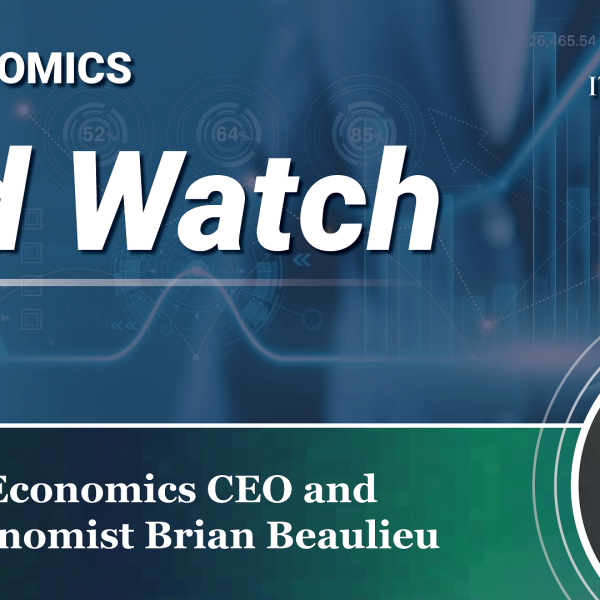- Mon - Fri: 8:30 - 5:00
- +1-603-796-2500
- ITR@itreconomics.com
with Brian Beaulieu
WEEKLY FED WATCH
This week on Fed Watch, ITR Economics Chief Economist Brian Beaulieu highlights the latest producer and consumer data from April and provides insight into why the economy is not as strong as some headlines make it out to be.
Key Episode Takeaways
- 0:18 – The economy is not as strong as some headlines say
- 1:02 – Producer Price Index data from April
- 2:30 – Looking at Consumer Price Index data
- 3:18 – What the data says about retail sales
- 3:53 – Single-Unit Housing Starts data
- 4:33 – The economy is going to continue to slow down
- 5:37 – Subscribe to By the Numbers to learn the facts behind the headlines
The below transcript is a literal translation of the podcast audio that has been machine generated by Rev.
Hello, thank you for joining us for this May 17th, 2024 edition of Fed Watch. I’m Brian Beaulieu. A lot of data came out this week, and I’ll tell you the summary right up front. The economy isn’t as strong as some of the headlines make it out to be. Inflation remains problematic, but the economy is slowly softening. And I mentioned the headlines, because I was looking at the BBC this morning, and one of their headlines was, “Is the US economy too strong?” Well, it’s probably too strong for Britain’s sake, but it isn’t too strong from a domestic perspective. And we saw our mortgage rates come down, which is good, but that’s not a sign of strength, that’s a sign of relative softening in the marketplace also. So let’s look at some of the data, see what the tidbits mean.
PPI for April came out, and that showed modest strengthening, the 1.12 increase to 2.1%. That’s phase B now. It’s not a problem at 2.1%, what’s the problem, and this is the ongoing story, right? The service sector of the producer price index, the services aspect, continues to fuel that rate of inflation. The goods rose, but not as much as the services. And within the goods, it was energy that accounted for most of the increase. Food pricing declined as a matter of fact. So it’s energy, which is a problem for consumers. And the overall PPI went up, which could be a problem for the bed. CPI however, for April, showed a modicum of improvement. There, the 1.12 rate of change eased a little bit down to 3.4%, it had been 3.5%. But we’re seeing the same old song and dance. Most of the increase, 70% of the increase, as a matter of fact, was because of shelter and gasoline in particular.
Shelter is at 5.5% on a year-over-year basis. It’s in a gradual phase C, so disinflation mode, but it’s taking its sweet time to come down. Core inflation eased to 3.6%, and that was noticeable, that had been at 3.8%. So at least it’s moving in the right direction, we can take some comfort in that. The service sector’s CPI, the services CPI is at 5.3%, and it’s not really coming down. It seems to be stuck at about that level. And that could give us all heartburn if we are pulling for interest rate decline. It’s noteworthy that, well, the CPI core even remains stuck at a relatively high level, too high a level, really. The durable good side of it, is at minus 3.2% year-over-year comparison, and that’s the lowest rate of 1.12. So the lowest amplitude, the most deflation we’ve seen in just about 20 years. So the good side of it is doing what it’s supposed to, it’s just the nasty services side.
On retail sales, and this is part of what I was mentioning when I said that we’re going to see a little bit of a slowing down, I think in the overall economy. The seasonal rise that began in April was barely normal. The rates of change, and you’ll see this in the ITI Trends report, the rates of change moved up, but that’s largely because of what we call reciprocal pressure. Last year was weak in April. It could be for a whole host of reasons, but the current movement in the data, is barely considered normal as well below average, as a matter of fact.
Housing starts, I looked at single family housing starts. That data came out this week, and that 3.12 [inaudible 00:03:59] change, has tentatively reversed direction, setting March as a high. And our analysis suggests that it is going to hold as a high, and we’re going to see that means the data trend levels off in housing 4Q this year, 1Q, 2025. We don’t think there’s going to be a recession per se in housing, but we’re going to lose some of this upward momentum. And that’s consistent with the forecast that we’ve been showing you in the ITR Trends report. And as I mentioned, those mortgage rates have come down.
What does this all mean for us? That slowing in the economy is going to continue. And part of what makes us say that is that we created this series looking at savings, consumer savings adjusted for inflation. And that’s down about 0.2% from last year. It’s been essentially flat-lining on this for the last 20 months. And over the last three months, it’s actually shown some noticeable decay. So we’re going to be keeping a close eye on that, if we’re seeing a slowdown in real personal income going up at the same time, the savings are being drawn down, it’s logical to assume that we’re going to get some more softening in retail sales, or at least a soft seasonal rising trend. We still think we’re going to get some interest rate decline in the second half of this year in those short term interest rates, but don’t think we’re going to see it before the third quarter.
Now, there’s a great way to watch, or literally watch, or listen, to all of these indicators that I talk about in greater detail, and that’s through By The Numbers. It’s a new service that we’re offering. It’s $30 a month. We have one of our senior economists meeting with our hosts, Lindsey Warnham. And together Lauren and Lindsay digest about four to six topics each week about what you need to know in a very conversational business-friendly manner. Check it out. You can go on our website and look at some previews. It’s called By The Numbers. At $30 a month, it might be an easy way for you to keep on track with more analysis along the lines of what we just talked about. Thanks for joining us for this edition of Fed Watch. See you next week.



